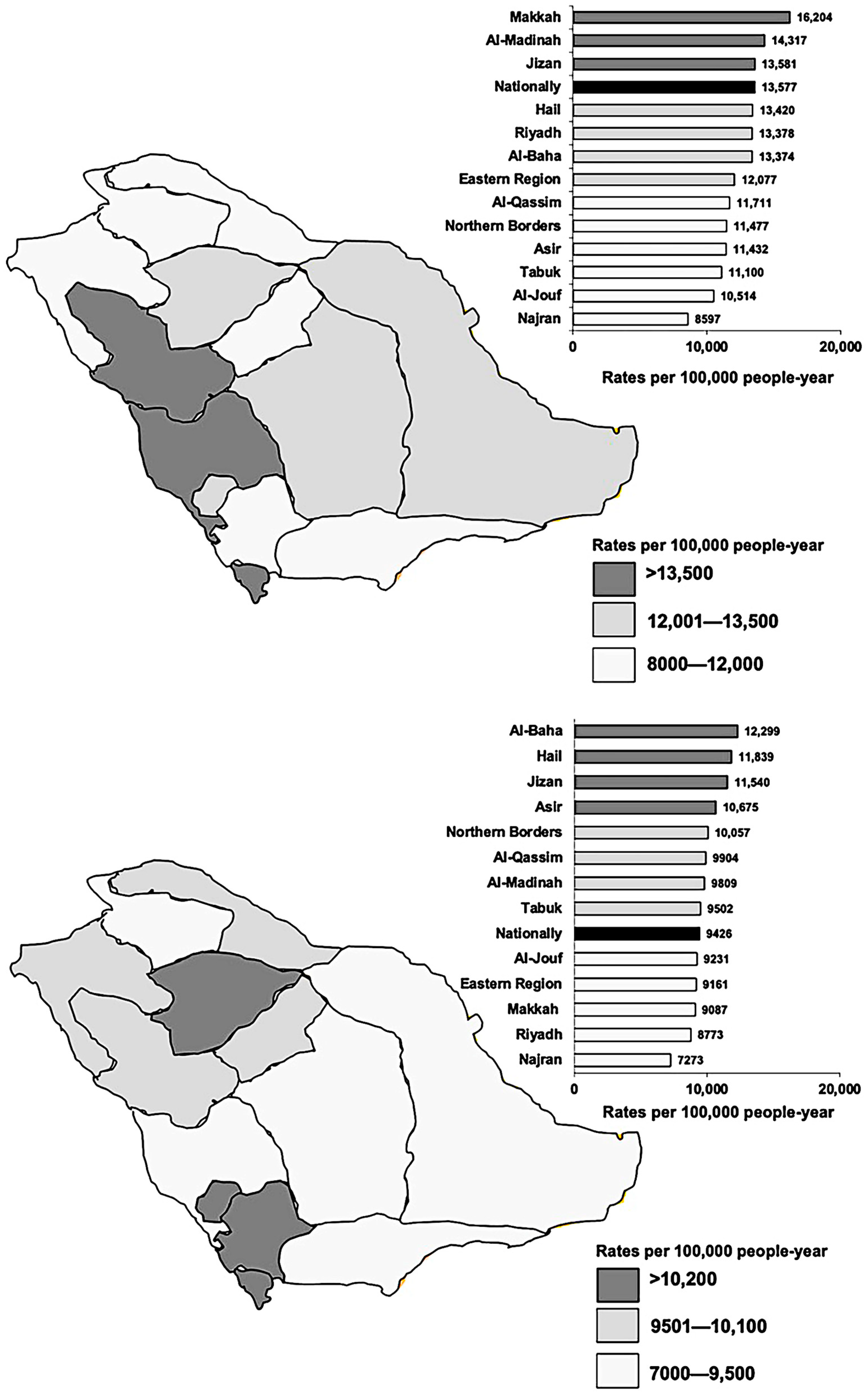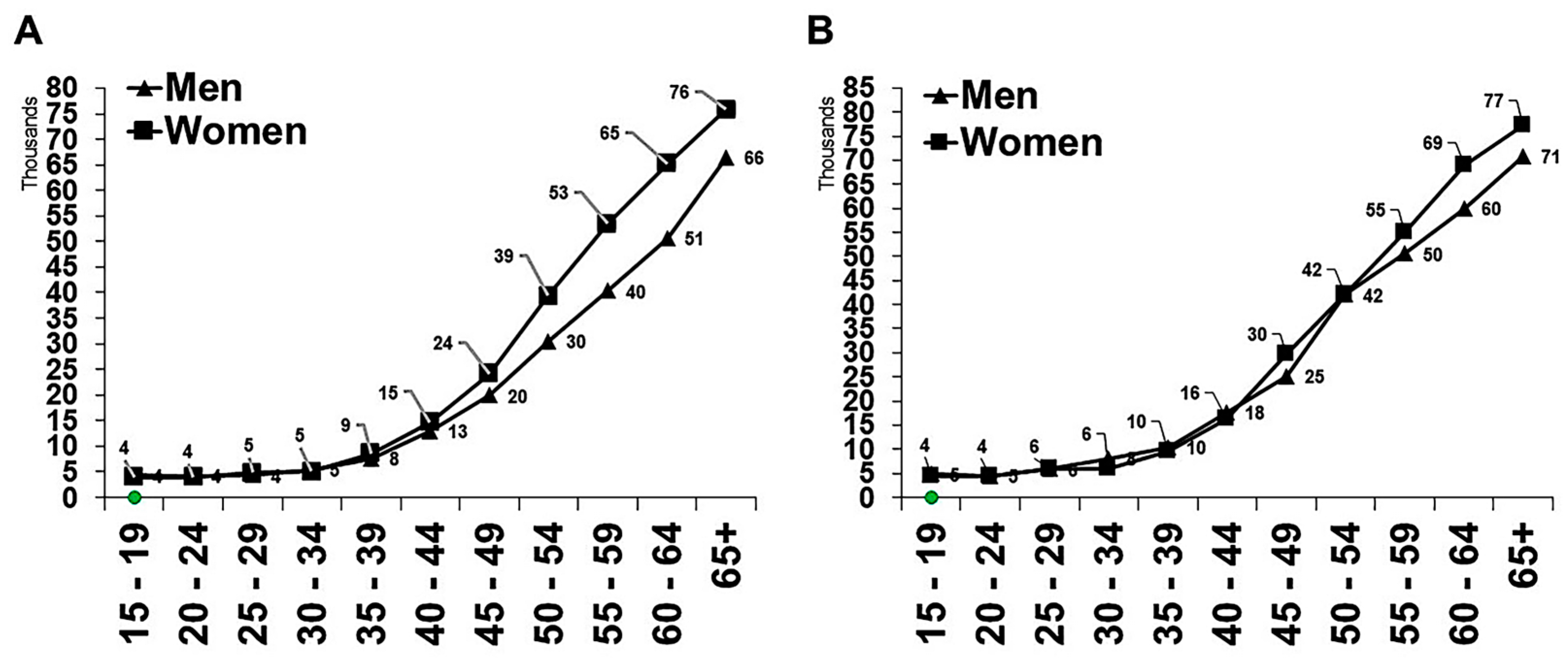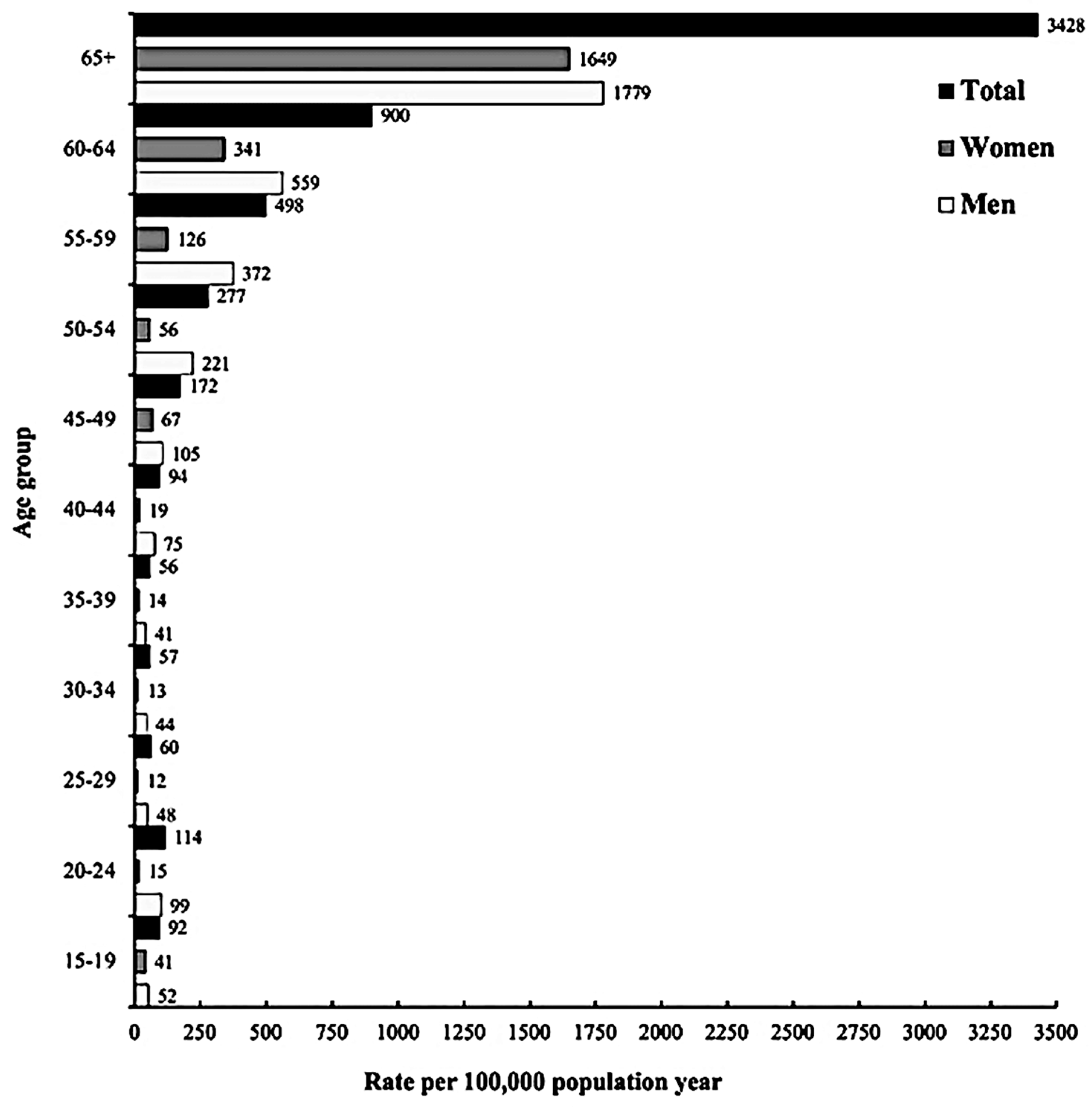National and Regional Rates of Chronic Diseases and All-Cause Mortality in Saudi Arabia—Analysis of the 2018 Household Health Survey Data
Abstract
1. Introduction
2. Materials and Methods
3. Results
4. Discussion
5. Conclusions
Author Contributions
Funding
Institutional Review Board Statement
Informed Consent Statement
Data Availability Statement
Acknowledgments
Conflicts of Interest
References
- Bernell, S.; Howard, S.W. Use Your Words Carefully: What Is a Chronic Disease? Front. Public Health 2016, 4, 159. [Google Scholar] [CrossRef]
- Harris, R.E. Epidemiology of Chronic Disease: Global Perspectives, 2nd ed.; Jones & Bartlett Learning: Burlington, MA, USA, 2019; pp. 1–901. [Google Scholar]
- Rudd, K.E.; Johnson, S.C.; Agesa, K.M.; Shackelford, K.A.; Tsoi, D.; Kievlan, D.R.; Colombara, D.V.; Ikuta, K.S.; Kissoon, N.; Finfer, S.; et al. Global, regional, and national sepsis incidence and mortality, 1990–2017: Analysis for the Global Burden of Disease Study. Lancet 2020, 395, 200–211. [Google Scholar] [CrossRef]
- Anderson, G.; Horvath, J. The growing burden of chronic disease in America. Public Health Rep. 2004, 119, 263–270. [Google Scholar] [CrossRef]
- GBD 2017 DALYs; HALE Collaborators. Global, regional, and national disability-adjusted life-years (DALYs) for 359 diseases and injuries and healthy life expectancy (HALE) for 195 countries and territories, 1990-2017: A systematic analysis for the Global Burden of Disease Study 2017. Lancet 2018, 392, 1859–1922. [Google Scholar] [CrossRef]
- GBD 2019 Stroke Collaborators. Global, regional, and national burden of diseases and injuries for adults 70 years and older: Systematic analysis for the Global Burden of Disease 2019 Study. BMJ 2022, 376, e068208. [Google Scholar]
- Memish, Z.A.; Jaber, S.; Mokdad, A.H.; AlMazroa, M.A.; Murray, C.J.; Al Rabeeah, A.A.; Saudi Burden of Disease Collaborators. Burden of disease, injuries, and risk factors in the Kingdom of Saudi Arabia, 1990–2010. Prev. Chronic Dis. 2014, 11, E169. [Google Scholar] [CrossRef]
- Saudi Arabian Ministry of Health Institute of Health Metrics and Evaluation Saudi Health Interview Survey Results. Available online: https://www.healthdata.org/sites/default/files/files/Projects/KSA/Saudi-Health-Interview-Survey-Results.pdf (accessed on 23 January 2023).
- GBD 2017 Saudi Arabia Collaborators. The burden of disease in Saudi Arabia 1990–2017: Results from the Global Burden of Disease Study 2017. Lancet Planet Health 2020, 4, e195–e208. [Google Scholar] [CrossRef]
- Rahman, R.; Al-Borie, H.M. Strengthening the Saudi Arabian healthcare system: Role of vision 2030. Int. J. Health Policy Manag. 2021, 14, 1483–1491. [Google Scholar] [CrossRef]
- Chowdhury, S.; Mok, D.; Leenen, L. Transformation of health care and the new model of care in Saudi Arabia: Kingdom’s Vision 2030. J. Med. Life Sci. 2021, 14, 347. [Google Scholar]
- Methodology Used for 2018 Household Health Survey. Available online: https://www.stats.gov.sa/en/node/37421 (accessed on 23 January 2023).
- Al Dawish, M.A.; Robert, A.A.; Braham, R.; Al Hayek, A.A.; Al Saeed, A.; Ahmed, R.A.; Al Sabaan, F.S. Diabetes Mellitus in Saudi Arabia: A Review of the Recent Literature. Curr. Diabetes Rev. 2016, 12, 359–368. [Google Scholar] [CrossRef]
- Aljefree, N.; Ahmed, F. Prevalence of cardiovascular disease and associated risk factors among adult population in the Gulf region: A systematic review. Adv. Public Health 2015, 2015, 235101. [Google Scholar] [CrossRef]
- Ahmed, A.M.; Hersi, A.; Mashhoud, W.; Arafah, M.R.; Abreu, P.C.; Al Rowaily, M.A.; Al-Mallah, M.H. Cardiovascular risk factors burden in Saudi Arabia: The Africa Middle East Cardiovascular Epidemiological (A.C.E.) study. J. Saudi Heart Assoc. 2017, 29, 235–243. [Google Scholar] [CrossRef]
- Saudi Health Interview Survey Finds High Rates of Chronic Diseases in the Kingdom of Saudi Arabia. Available online: https://www.healthdata.org/news-release/saudi-health-interview-survey-finds-high-rates-chronic-diseases-kingdom-saudi-arabia (accessed on 23 January 2023).
- Lowry, R.; Kann, L.; Collins, J.L.; Kolbe, L.J. The effect of socioeconomic status on chronic disease risk behaviors among U.S. adolescents. JAMA 1996, 276, 792–797. [Google Scholar] [CrossRef]
- Alhabib, K.F.; Batais, M.A.; Almigbal, T.H.; Alshamiri, M.Q.; Altaradi, H.; Rangarajan, S.; Yusuf, S. Demographic, behavioral, and cardiovascular disease risk factors in the Saudi population: Results from the Prospective Urban Rural Epidemiology study (PURE-Saudi). BMC Public Health 2020, 20, 1213. [Google Scholar] [CrossRef]
- GBD 2019 Stroke Collaborators. Global, regional, and national burden of stroke and its risk factors, 1990–2019: A systematic analysis for the Global Burden of Disease Study 2019. Lancet Neurol. 2021, 20, 795–820. [Google Scholar] [CrossRef]
- Safiri, S.; Noori, M.; Nejadghaderi, S.A.; Mousavi, S.E.; Sullman, M.J.M.; Araj-Khodaei, M.; Singh, K.; Kolahi, A.A.; Gharagozli, K. The burden of Parkinson’s disease in the Middle East and North Africa region, 1990–2019: Results from the global burden of disease study 2019. BMC Public Health 2023, 23, 107. [Google Scholar] [CrossRef]
- Rees-Punia, E.; Deubler, E.; Campbell, P.; Gapstur, S.M.; Patel, A. Light-Intensity Physical Activity in a Large Prospective Cohort of Older US Adults: A 21-Year Follow-Up of Mortality. Gerontology 2020, 66, 259–265. [Google Scholar] [CrossRef]
- Remington, P.L.; Simoes, E.; Brownson, R.C.; Siegel, P.Z. The role of epidemiology in chronic disease prevention and health promotion programs. J. Public Health Manag. Pract. 2003, 9, 258–265. [Google Scholar] [CrossRef]
- Tiwari, S.C. Loneliness: A disease? Indian J. Psychiatry 2013, 55, 320–322. [Google Scholar] [CrossRef]
- Theeke, L.A. Predictors of loneliness in U.S. adults over age sixty-five. Arch. Psychiatr. Nurs. 2009, 23, 387–396. [Google Scholar] [CrossRef]
- Lee, D.C.; Shi, L.; Pierre, G.; Zhu, J.; Hu, R. Chronic conditions and medical expenditures among non-institutionalized adults in the United States. Int. J. Equity Health 2014, 13, 105. [Google Scholar] [CrossRef] [PubMed]
- Larkin, J.; Foley, L.; Smith, S.M.; Harrington, P.; Clyne, B. The experience of financial burden for people with multimorbidity: A systematic review of qualitative research. Health Expect 2021, 24, 282–295. [Google Scholar] [CrossRef] [PubMed]
- Sum, G.; Hone, T.; Atun, R.; Millett, C.; Suhrcke, M.; Mahal, A.; Koh, G.C.; Lee, J.T. Multimorbidity and out-of-pocket expenditure on medicines: A systematic review. BMJ Glob. Health 2018, 3, e000505. [Google Scholar] [CrossRef] [PubMed]
- Schoen, C.; Osborn, R.; How, S.K.; Doty, M.M.; Peugh, J. In chronic condition: Experiences of patients with complex health care needs, in eight countries, 2008. Health Aff (Millwood) 2009, 28, w1-16. [Google Scholar] [CrossRef] [PubMed]
- Winter, S.J.; King, A.C.; Stafford, R.S.; Winkleby, M.A.; Haskell, W.L.; Farquhar, J.W. Promoting culturally targeted chronic disease prevention research through an adapted participatory research approach: The Qassim-Stanford Universities project. Transl. Behav. Med. 2011, 1, 289–298. [Google Scholar] [CrossRef]
- Halverson, P.K.; Miller, C.A.; Kaluzny, A.D.; Fried, B.J.; Schenck, S.E.; Richards, T.B. Performing public health functions: The perceived contribution of public health and other community agencies. J. Health Hum. Serv. Adm 1996, 18, 288–303. [Google Scholar]
- Mays, G.P.; Smith, S.A. Evidence links increases in public health spending to declines in preventable deaths. Health Aff (Millwood) 2011, 30, 1585–1593. [Google Scholar] [CrossRef]
- Cutler, D.M. Are we finally winning the war on cancer? J. Econ. Perspect. 2008, 22, 3–26. [Google Scholar] [CrossRef]
- Whear, R.; Thompson-Coon, J.; Rogers, M.; Abbott, R.A.; Anderson, L.; Ukoumunne, O.; Matthews, J.; Goodwin, V.A.; Briscoe, S.; Perry, M.; et al. Patient-initiated appointment systems for adults with chronic conditions in secondary care. Cochrane Database Syst. Rev. 2020, 4, CD010763. [Google Scholar] [CrossRef]
- Robert, A.A.; Al Dawish, M.A. The Worrying Trend of Diabetes Mellitus in Saudi Arabia: An Urgent Call to Action. Curr. Diabetes Rev. 2020, 16, 204–210. [Google Scholar] [CrossRef]
- Sikorski, C.; Luppa, M.; Kaiser, M.; Glaesmer, H.; Schomerus, G.; Konig, H.H.; Riedel-Heller, S.G. The stigma of obesity in the general public and its implications for public health—A systematic review. BMC Public Health 2011, 11, 661. [Google Scholar] [CrossRef] [PubMed]
- Alfadda, A.A.; Al-Dhwayan, M.M.; Alharbi, A.A.; Al Khudhair, B.K.; Al Nozha, O.M.; Al-Qahtani, N.M.; Alzahrani, S.H.; Bardisi, W.M.; Sallam, R.M.; Riva, J.J.; et al. The Saudi clinical practice guideline for the management of overweight and obesity in adults. Saudi Med. J. 2016, 37, 1151–1162. [Google Scholar] [CrossRef] [PubMed]
- Basheikh, M.A.; Balubaid, H.; Mohammed, B.; Hashim, B. Kingdom of Saudi Arabia. Int. J. Ageing Dev. Ctries 2021, 6, 141–154. [Google Scholar]
- Shahid, Z.; Kalayanamitra, R.; McClafferty, B.; Kepko, D.; Ramgobin, D.; Patel, R.; Aggarwal, C.S.; Vunnam, R.; Sahu, N.; Bhatt, D.; et al. COVID-19 and Older Adults: What We Know. J. Am. Geriatr. Soc. 2020, 68, 926–929. [Google Scholar] [CrossRef] [PubMed]
- Yanez, N.D.; Weiss, N.S.; Romand, J.A.; Treggiari, M.M. COVID-19 mortality risk for older men and women. BMC Public Health 2020, 20, 1742. [Google Scholar] [CrossRef] [PubMed]
- Cohen, H.W. Limitations of an ecological study: A review. Am. J. Hypertens. 2005, 18, 750. [Google Scholar] [CrossRef]
- Al-Rasadi, K.; Alhabib, K.F.; Al-Allaf, F.; Al-Waili, K.; Al-Zakwani, I.; AlSarraf, A.; Almahmeed, W.; AlSayed, N.; Alghamdi, M.; Batais, M.A.; et al. The Gulf Familial Hypercholesterolemia Registry (Gulf F.H.): Design, Rationale and Preliminary Results. Curr. Vasc. Pharmacol. 2020, 18, 57–64. [Google Scholar] [CrossRef]



| The Administrative Region | No. of Households | No. of Population | Total Population π | Saudi Population ψ | ||||||
|---|---|---|---|---|---|---|---|---|---|---|
| DM Rate (95% CI) (%) ¶ | HTN Rate (95% CI) (%) ¶ | CAD Rate (95% CI) (%) ¶ | CN Rate (95% CI) (%) ¶ | DM Rate (95% CI) (%) ¶ | HTN Rate (95% CI) (%) ¶ | CAD Rate (95% CI) (%) ¶ | CN Rate (95% CI) (%) ¶ | |||
| Riyadh | 3726 | 8,216,284 | 6494 (6234–19,222) (6.5) | 5844 (5610–17,297) (5.8) | 864 (830–2558) (0.9) | 176 (169–520) (0.2) | 4176 (4009–12,360) (4.2) | 3777 (3626–11,180) (3.8) | 689 (662–2040) (0.7) | 131 (125–387) (0.1) |
| Makkah | 4356 | 8,557,766 | 7931 (7614–23,476) (7.9) | 7009 (6729–20,746) (7.0) | 1168 (1122–3458) (1.2) | 96 (92–283) (0.1) | 4266 (4096–12,628) (4.3) | 3987 (3828–12,360) (4.0) | 747 (717–2211) (0.7) | 87 (83–256) (0.1) |
| Al-Madinah | 1656 | 2,132,679 | 6433 (6176–19,042) (6.4) | 6704 (6436–19,843) (6.7) | 1054 (1012–3121) (1.1) | 126 (121–372) (0.1) | 4696 (4508–13,899) (4.7) | 4292 (4120–12,703) (4.3) | 696 (669–2061) (0.7) | 126 (121–372) (0.1) |
| Al-Qassim | 1188 | 1,423,935 | 5670 (5443–16,783) (5.7) | 4999 (4799–14,796) (5.0) | 870 (836–2577) (0.9) | 171 (165–508) (0.2) | 4527 (4346–13,399) (4.5) | 4421 (4244–13,085) (4.4) | 785 (754–2324) (0.8) | 171 (165–508) (0.2) |
| Eastern Region | 3024 | 4,900,325 | 5936 (5699–17,571) (5.9) | 5209 (5000–15,418) (5.2) | 794 (762–2351) (0.8) | 138 (133–409) (0.1) | 4303 (4131–12,736) (4.3) | 4048 (3886–11,983) (4.0) | 671 (644–1987) (0.7) | 138 (133–409) (0.1) |
| Asir | 1620 | 2,211,875 | 5354 (5140–15,848) (5.4) | 4993 (4794–14,780) (5.0) | 944 (906–2794) (0.9) | 141 (135–417) (0.1) | 4970 (4772–14,713) (5.0) | 4667 (4480–13,813) (4.7) | 897 (861–2654) (0.9) | 141 (135–417) (0.1) |
| Tabuk | 1314 | 910,030 | 5933 (5696–17,562) (5.9) | 4302 (4130–12,734) (4.3) | 743 (713–2199) (0.7) | 122 (117–362) (0.1) | 4928 (4731–14,588) (4.9) | 3791 (3640–11,223) (3.8) | 702 (674–2077) (0.7) | 81 (78–239) (0.1) |
| Ha’il | 1170 | 699,774 | 7072 (6789–20,933) (7.1) | 5312 (5100–15,724) (5.3) | 880 (845–2606) (0.9) | 155 (149–459) (0.2) | 5933 (5695–17,561) (5.9) | 4911 (4714–14,536) (4.9) | 840 (806–2486) (0.8) | 155 (149–459) (0.2) |
| Northern borders | 1260 | 365,231 | 6231 (5982–18,444) (6.2) | 4215 (4046–12,476) (4.2) | 877 (842–2596) (0.9) | 154 (148–456) (0.2) | 5,13 (4926–15,188) (5.1) | 3995 (3835–11,824) (4.0) | 795 (763–2352) (0.8) | 137 (132–406) (0.1) |
| Jizan | 1278 | 1,567,547 | 6817 (6544–20,178) (6.8) | 5822 (5589–17,232) (5.8) | 784 (752–2319) (0.8) | 160 (153–473) (0.2) | 5744 (5514–17,003) (5.7) | 4962 (4763–14,687) (5.0) | 743 (713–2198) (0.7) | 91 (88–270) (0.1) |
| Najran | 1152 | 582,243 | 4699 (4511–13,909) (4.7) | 3369 (3235–9973) (3.4) | 385 (370–1140) (0.4) | 143 (138–424) (0.1) | 3733 (3583–11,049) (3.7) | 3037 (2915–8989) (3.0) | 385 (370–1140) (0.4) | 119 (114–351) (0.1) |
| Al-Baha | 1080 | 476,172 | 6264 (6013–18,541) (6.3) | 5940 (5702–17,582) (5.9) | 1056 (1014–3127) (1.1) | 113 (109–336) (0.1) | 5825 (5592–17,243) (5.8) | 5451 (5233–16,136) (5.5) | 909 (873–2691) (0.9) | 113 (109–336) (0.1) |
| Al-Jawf | 1188 | 508,475 | 5202 (4994–15,398) (5.2) | 4270 (4099–12,638) (4.3) | 882 (847–2611) (0.9) | 161 (154–476) (0.2) | 4468 (4290–13,227) (4.5) | 3874 (3719–11,466) (3.9) | 814 (782–2411) (0.8) | 75 (72–222) (0.1) |
| Total | 24,012 | 32,552,336 | 6624 (6359–19,607) (6.6) | 5875 (5640–17,389) (5.9) | 940 (902–2781) (0.9) | 138 (133–410) (0.1) | 4488 (4308–13,284) (4.5) | 4093 (3929–12,114) (4.1) | 727 (698–2153) (0.7) | 118 (114–350) (0.1) |
| The Administrative Region | Men | Women | ||||||
|---|---|---|---|---|---|---|---|---|
| DM | HTN | CAD | CN | DM | HTN | CAD | CN | |
| Riyadh | 8522 | 7274 | 1244 | 156 | 7945 | 7791 | 878 | 336 |
| Makkah | 11,034 | 8665 | 1595 | 75 | 8589 | 9157 | 1309 | 187 |
| Al-Madinah | 8169 | 7607 | 1131 | 116 | 8815 | 10,455 | 1736 | 233 |
| Al-Qassim | 6832 | 5354 | 1217 | 120 | 8058 | 8115 | 982 | 374 |
| Eastern Region | 7077 | 5891 | 844 | 88 | 8401 | 7905 | 1296 | 324 |
| Asir | 7002 | 5318 | 1272 | 64 | 7250 | 8305 | 1231 | 343 |
| Tabuk | 8111 | 5095 | 1202 | 254 | 8146 | 7010 | 759 | 45 |
| Ha’il | 8519 | 6248 | 1150 | 50 | 10,104 | 7788 | 1140 | 402 |
| Northern borders | 7857 | 4904 | 1420 | 226 | 9158 | 6732 | 878 | 185 |
| Jizan | 9386 | 6573 | 1183 | 187 | 8680 | 9201 | 868 | 244 |
| Najran | 7190 | 4407 | 523 | 55 | 5399 | 4890 | 532 | 388 |
| Al-Baha | 8156 | 6154 | 1758 | 80 | 8046 | 9533 | 896 | 228 |
| Al-Jawf | 6488 | 4773 | 1135 | 104 | 8171 | 7528 | 1334 | 396 |
| Total | 8730 | 7008 | 1256 | 113 | 8265 | 8422 | 1145 | 276 |
| The Administrative Region | Men | Women | ||||||
|---|---|---|---|---|---|---|---|---|
| DM | HTN | CAD | CN | DM | HTN | CAD | CN | |
| Riyadh | 10,530 | 8905 | 2127 | 280 | 1314 | 10,200 | 1314 | 383 |
| Makkah | 11,516 | 9524 | 2212 | 132 | 1616 | 10,990 | 1616 | 316 |
| Al-Madinah | 10,883 | 8781 | 1752 | 230 | 1359 | 10,413 | 1359 | 332 |
| Al-Qassim | 8260 | 8164 | 1901 | 222 | 1230 | 9548 | 1230 | 469 |
| Eastern Region | 9074 | 7990 | 1342 | 183 | 1632 | 9953 | 1632 | 438 |
| Asir | 9626 | 7410 | 1793 | 100 | 1421 | 9222 | 1421 | 396 |
| Tabuk | 9285 | 6042 | 1686 | 240 | 881 | 8033 | 881 | 53 |
| Ha’il | 10,128 | 9070 | 1717 | 82 | 1354 | 8849 | 1354 | 477 |
| Northern borders | 8807 | 6876 | 1893 | 350 | 1037 | 7844 | 1037 | 156 |
| Jizan | 11,159 | 7867 | 1677 | 60 | 983 | 9944 | 983 | 268 |
| Najran | 8408 | 6343 | 864 | 91 | 650 | 5598 | 650 | 376 |
| Al-Baha | 10,858 | 8055 | 2151 | 121 | 1022 | 10,485 | 1022 | 260 |
| Al-Jawf | 8834 | 6798 | 1724 | 183 | 1650 | 9312 | 1650 | 127 |
| Total | 10,261 | 8451 | 1873 | 183 | 1388 | 9977 | 1388 | 352 |
Disclaimer/Publisher’s Note: The statements, opinions and data contained in all publications are solely those of the individual author(s) and contributor(s) and not of MDPI and/or the editor(s). MDPI and/or the editor(s) disclaim responsibility for any injury to people or property resulting from any ideas, methods, instructions or products referred to in the content. |
© 2023 by the authors. Licensee MDPI, Basel, Switzerland. This article is an open access article distributed under the terms and conditions of the Creative Commons Attribution (CC BY) license (https://creativecommons.org/licenses/by/4.0/).
Share and Cite
Alzahrani, M.S.; Alharthi, Y.S.; Aljamal, J.K.; Alarfaj, A.A.; Vennu, V.; Noweir, M.D. National and Regional Rates of Chronic Diseases and All-Cause Mortality in Saudi Arabia—Analysis of the 2018 Household Health Survey Data. Int. J. Environ. Res. Public Health 2023, 20, 5254. https://doi.org/10.3390/ijerph20075254
Alzahrani MS, Alharthi YS, Aljamal JK, Alarfaj AA, Vennu V, Noweir MD. National and Regional Rates of Chronic Diseases and All-Cause Mortality in Saudi Arabia—Analysis of the 2018 Household Health Survey Data. International Journal of Environmental Research and Public Health. 2023; 20(7):5254. https://doi.org/10.3390/ijerph20075254
Chicago/Turabian StyleAlzahrani, Majed S., Yaser S. Alharthi, Jamal K. Aljamal, Abdulrahman A. Alarfaj, Vishal Vennu, and Mohammed D. Noweir. 2023. "National and Regional Rates of Chronic Diseases and All-Cause Mortality in Saudi Arabia—Analysis of the 2018 Household Health Survey Data" International Journal of Environmental Research and Public Health 20, no. 7: 5254. https://doi.org/10.3390/ijerph20075254
APA StyleAlzahrani, M. S., Alharthi, Y. S., Aljamal, J. K., Alarfaj, A. A., Vennu, V., & Noweir, M. D. (2023). National and Regional Rates of Chronic Diseases and All-Cause Mortality in Saudi Arabia—Analysis of the 2018 Household Health Survey Data. International Journal of Environmental Research and Public Health, 20(7), 5254. https://doi.org/10.3390/ijerph20075254







